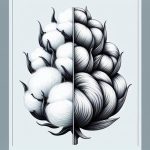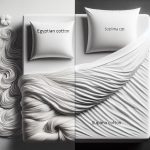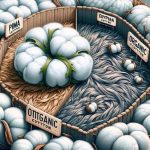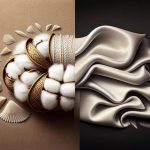Are you struggling to differentiate between various types of cotton fabric? Look no further! In this article, we simplify the identification process for you.
We’ll explore natural cotton, organic cotton, Pima cotton, Egyptian cotton, Supima cotton, and blended cotton fabrics. By the end, you’ll be able to confidently distinguish between these different kinds of cotton fabric.
So, get ready to become a cotton connoisseur and make informed choices for your next textile purchase!
Table of Contents
Natural Cotton Fabric
To identify natural cotton fabric, you can look for the presence of small seeds called ‘cotton bolls’ within the fabric itself. Natural cotton fabric is highly sought after due to its comfort, breathability, and sustainability. As people become more conscious of the environmental impact of their choices, natural cotton alternatives and eco-friendly cotton options are gaining popularity.
When it comes to natural cotton alternatives, there are a few options to consider. One popular alternative is organic cotton, which is grown without the use of synthetic fertilizers or pesticides. This ensures that the fabric is free from harmful chemicals, making it safer for both the environment and the wearer. Another alternative is recycled cotton, which is made from post-industrial or post-consumer waste. This process reduces the demand for new cotton production and helps to minimize waste.
In addition to natural cotton alternatives, eco-friendly cotton options are also available. These options focus on reducing the water and energy usage during the production process. For example, some manufacturers use innovative techniques such as rainwater harvesting and solar power to minimize the environmental impact. Additionally, certain certifications, like the Global Organic Textile Standard (GOTS), ensure that the cotton fabric meets strict environmental and social criteria.
Organic Cotton Fabric
When it comes to organic cotton fabric, you’ll be pleased to know that it offers several benefits.
Not only is it better for the environment, but it’s also free from harmful chemicals and pesticides.
Additionally, organic cotton fabric is produced using sustainable farming practices, ensuring a healthier and more sustainable future for the textile industry.
Benefits of Organic Cotton
You can experience numerous benefits by choosing organic cotton fabric.
One of the advantages of organic cotton is its positive environmental impact. Unlike conventional cotton, which is grown with the use of synthetic pesticides and fertilizers, organic cotton is cultivated using natural methods. This means that organic cotton farming helps to preserve soil fertility and biodiversity, while also reducing water pollution. Additionally, organic cotton production uses less water compared to conventional cotton farming.
By opting for organic cotton fabric, you contribute to the reduction of harmful chemicals in the environment and support sustainable agricultural practices. Not only is organic cotton better for the planet, but it’s also better for your health as it’s free from harmful residues.
Making the switch to organic cotton fabric is a simple and effective way to make a positive impact on the environment.
Certification Requirements for Organic Cotton
By choosing organic cotton fabric, you can ensure that it meets the certification requirements for organic cotton, which are essential for verifying its environmental and health benefits. The certification process for organic cotton involves rigorous standards that must be met by farmers and manufacturers.
These standards include using natural fertilizers and pesticides, practicing crop rotation, and avoiding the use of genetically modified organisms (GMOs). Organic cotton is also grown without the use of synthetic chemicals, which reduces its environmental impact and protects the health of farmers and consumers.
Certification organizations, such as the Global Organic Textile Standard (GOTS) and the Organic Content Standard (OCS), play a crucial role in ensuring that organic cotton fabric meets these requirements. By looking for products with these certifications, you can be confident that you’re purchasing cotton fabric that isn’t only better for the environment but also safer for you and your loved ones.
Sustainable Farming Practices
To understand sustainable farming practices for organic cotton fabric, it is important to consider the methods used by farmers and how they contribute to environmental conservation. Organic cotton is grown using regenerative agriculture, which focuses on building soil health and biodiversity, reducing water usage, and minimizing the use of synthetic chemicals. This approach not only ensures the long-term viability of the land but also helps combat climate change by sequestering carbon in the soil. Additionally, fair trade cotton ensures that farmers receive fair wages and work in safe conditions. By supporting sustainable farming practices and choosing organic and fair trade cotton fabrics, you can make a positive impact on the environment and support farmers in developing countries.
| Pros | Cons |
|---|---|
| Environmental conservation | Higher production costs |
| Soil health | Lower yields |
| Biodiversity | Limited availability |
| Carbon sequestration | Longer transition period |
| Fair wages for farmers |
Pima Cotton Fabric
Pima cotton fabric is known for its superior quality and softness, making it a popular choice for clothing and bedding.
When comparing Pima cotton to other types of cotton, you’ll find that it has longer and stronger fibers, resulting in a smoother and more durable fabric.
Pima Cotton Characteristics
When identifying different kinds of cotton fabric, you can easily recognize the characteristics of Pima cotton fabric. Pima cotton is known for its exceptional durability, making it a popular choice for high-quality clothing that can withstand frequent wear and washing. Its long staple length contributes to its strength, allowing it to maintain its shape and integrity over time.
In addition to its durability, Pima cotton is also prized for its softness. The fibers are smooth and luxurious to the touch, providing a comfortable and cozy feel against the skin.
With Pima cotton fabric, you can expect a combination of long-lasting durability and unmatched softness, making it a top choice for those seeking both quality and comfort.
- Exceptional durability
- Long staple length for strength
- Smooth and luxurious feel
- Comfortable against the skin
Pima Vs. Other Cottons
When comparing Pima cotton fabric to other types of cotton, you’ll notice its superior characteristics and qualities.
Pima cotton is often compared to Egyptian cotton due to their similarities in terms of softness and durability. However, Pima cotton stands out with its exceptional strength, making it less prone to tearing or pilling. Pima cotton also has a longer fiber length, resulting in smoother and more luxurious fabrics.
Additionally, Pima cotton fabrics have excellent breathability, keeping you cool and comfortable in warm weather. The benefits of Pima cotton extend beyond its superior quality. It’s also known for its hypoallergenic properties, making it a great choice for those with sensitive skin.
Benefits of Choosing Pima
By selecting Pima cotton fabric, you can enjoy numerous benefits that enhance your comfort and style. Pima cotton is known for its exceptional quality and luxurious feel. Here are some advantages of choosing Pima:
-
Softness: Pima cotton is renowned for its incredibly soft texture, making it incredibly comfortable to wear.
-
Durability: Pima cotton fabric is highly durable, ensuring that your clothing will last longer and withstand frequent washing and wearing.
-
Breathability: Pima cotton is highly breathable, allowing air to circulate and keeping you cool during hot weather.
-
Resistance to pilling: Pima cotton fabric has a natural resistance to pilling, ensuring that your garments will remain smooth and free from unsightly fuzz.
Selecting Pima cotton fabric not only ensures durability, but also provides you with unparalleled comfort and style. So why settle for anything less? Choose Pima and experience the difference.
Egyptian Cotton Fabric
To identify Egyptian cotton fabric, you can start by examining the fabric closely. Egyptian cotton is known for its exceptional quality and luxurious feel. It is cultivated in Egypt, where the climate and soil conditions are ideal for its growth. Egyptian cotton fibers are longer and finer than other types of cotton, making them stronger and more durable. This results in fabric that is softer, smoother, and more breathable.
To further understand the characteristics of Egyptian cotton fabric, refer to the table below:
| Characteristics | Description |
|---|---|
| Fiber Length | Longer |
| Fiber Fineness | Finer |
| Strength | Stronger |
| Softness | Softer |
| Breathability | More |
| Durability | Higher |
These characteristics make Egyptian cotton fabric highly sought after in the textile industry. It is often used to make luxurious bed sheets, towels, and clothing. When shopping for Egyptian cotton fabric, look for labels that specify "100% Egyptian cotton" to ensure you are getting the authentic product. Keep in mind that due to its superior quality, Egyptian cotton fabric may be more expensive than other types of cotton. However, the investment is worth it for the comfort and longevity it provides.
Supima Cotton Fabric
Now let’s move on to Supima cotton fabric, which is another type of high-quality cotton.
Here are some key points to consider about Supima cotton:
-
Supima cotton is known for its exceptional softness and durability. It’s often compared to Egyptian cotton in terms of quality.
-
Supima cotton is grown exclusively in the United States. It’s made from the fibers of the Pima cotton plant, which is a type of extra-long staple cotton.
-
Unlike Egyptian cotton, which is grown in Egypt, Supima cotton is subject to strict quality standards and regulations. This ensures that only the finest fibers are used in the production of Supima cotton fabric.
-
The benefits of using Supima cotton fabric are numerous. It’s highly absorbent, allowing it to wick away moisture from the body. It’s also hypoallergenic, making it ideal for those with sensitive skin. Additionally, Supima cotton fabric is known for its color retention and resistance to pilling.
Blended Cotton Fabric
Moving on to blended cotton fabric, let’s explore its characteristics and advantages. Blended cotton fabric is a combination of cotton and another type of fiber, such as polyester or rayon. This blend offers several benefits that make it a popular choice in the textile industry.
One of the main advantages of blended cotton fabric is its durability. The addition of synthetic fibers increases the fabric’s strength and resistance to wear and tear. This makes it ideal for garments and household items that are subject to frequent use.
Blended cotton fabric also has improved wrinkle resistance and shape retention compared to 100% cotton. This means that your clothes will stay looking fresh and maintain their shape even after multiple washes.
In terms of the manufacturing process, blended cotton fabric is created by combining the cotton fibers with the synthetic fibers during the spinning process. The fibers are then woven together to create the final fabric.
To help you understand the characteristics and advantages of blended cotton fabric better, here is a table summarizing its key features:
| Characteristics | Advantages |
|---|---|
| Durability | Resistant to wear and tear |
| Wrinkle resistance | Maintains a fresh appearance |
| Shape retention | Keeps its shape after multiple washes |
Blended cotton fabric offers the best of both worlds, combining the comfort and breathability of cotton with the added benefits of synthetic fibers. Whether you’re looking for clothing that lasts longer or household items that retain their shape, blended cotton fabric is a great choice.
Frequently Asked Questions
How Do I Identify the Different Kinds of Cotton Fabric?
To identify different kinds of cotton fabric, start by understanding cotton blends and the various cotton fabric weaves. Look for labels that indicate the fabric content and feel the fabric’s texture to determine its type.
What Are the Benefits of Using Organic Cotton Fabric?
Using organic cotton fabric has several benefits. It is better for your skin, as it doesn’t contain harmful chemicals. Additionally, organic cotton farming reduces the negative impact on the environment compared to conventional cotton farming.
Is Pima Cotton Fabric More Durable Than Regular Cotton Fabric?
Yes, pima cotton fabric is more durable than regular cotton fabric. It has longer fibers which make it stronger. If you’re comparing pima cotton vs organic cotton, pima cotton is still more durable.
What Makes Egyptian Cotton Fabric Unique and Superior?
Egyptian cotton fabric is unique and superior because it is known for its luxury and quality. The extra-long fibers make it softer and more durable, creating a fabric that is highly prized in the textile industry.
How Does Supima Cotton Fabric Differ From Other Types of Cotton Fabric?
Supima cotton fabric differs from regular cotton fabric in terms of its superior quality and properties. It is known for being softer, stronger, and more durable. It also has a longer fiber length, making it ideal for luxurious and high-quality garments.
- Does Linen Keep You Cool at Night? - April 9, 2024
- Is Linen Cool for Sleeping? - April 9, 2024
- Is Linen Sun Proof? - April 9, 2024







